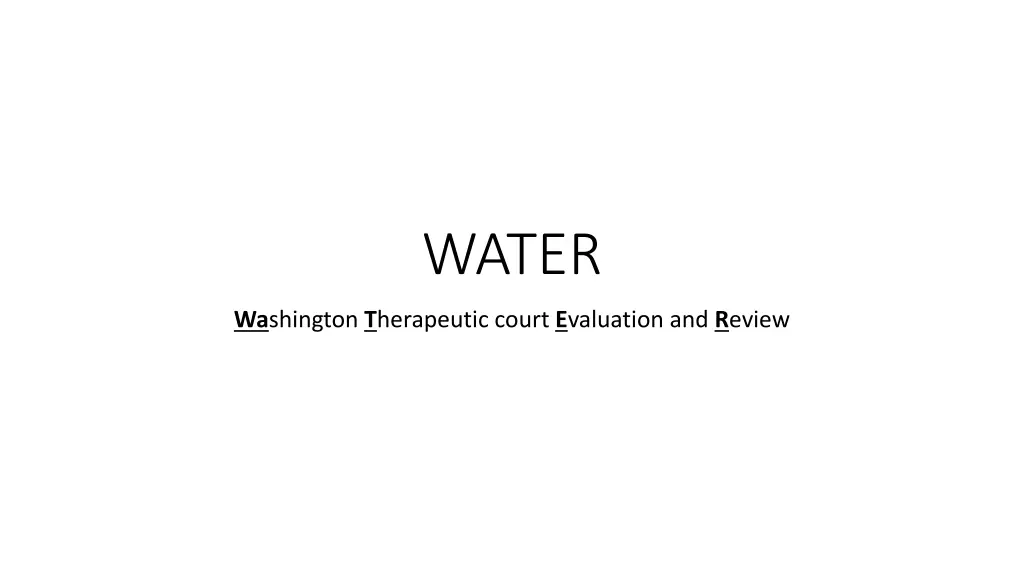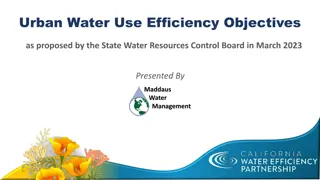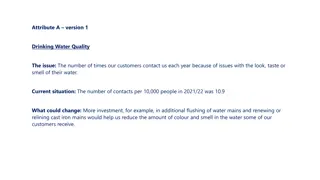
Therapeutic Court Evaluation and Review in Washington State
Explore the WATER tool, designed for self-review of court processes in therapeutic courts. Discover its purpose, module overview, target population, role of the judicial officer and team, treatment options, incentives and drug testing practices, program completion, and monitoring and evaluation. Learn about the Racial and Ethnic Disparities (RED) Program Assessment Tool.
Download Presentation

Please find below an Image/Link to download the presentation.
The content on the website is provided AS IS for your information and personal use only. It may not be sold, licensed, or shared on other websites without obtaining consent from the author. If you encounter any issues during the download, it is possible that the publisher has removed the file from their server.
You are allowed to download the files provided on this website for personal or commercial use, subject to the condition that they are used lawfully. All files are the property of their respective owners.
The content on the website is provided AS IS for your information and personal use only. It may not be sold, licensed, or shared on other websites without obtaining consent from the author.
E N D
Presentation Transcript
WATER Washington Therapeutic court Evaluation and Review
Purpose of the WATER Tool for your toolbox Self-review court processes Gather information to help make decisions Identify strengths and challenges
Module Overview Target population Role of the judicial officer and multidisciplinary team Treatment Incentives, responses, and drug testing Program completion Census, caseloads, monitoring, and evaluation The Racial and Ethnic Disparities (RED) Program Assessment Tool
Target Population Program requirements Program materials Who s entering the program? Example results from a summary report: To be decided.
Role of Judicial Officer and Team Who s on the team? Decision-making Training Team environment Staffings Court hearings Example results from a summary report: To be decided.
Treatment Substance use disorder (SUD) treatment Mental health treatment Therapeutic adjustments Example results from a summary report: To be decided.
Incentives, Responses, and Drug Testing Drug testing practices Incentive policies Response policies Participant engagement Example results from a summary report: To be decided.
Program Completion Participant outcomes Race equity in outcomes Reasons for outcomes Example results from a summary report: To be decided.
Census, Caseloads, Monitoring & Evaluation Capacity of program Utilization of capacity Data collection & review Evaluations Using evaluations Example results from a summary report: To be decided.
The Racial and Ethnic Disparities (RED) Program Assessment Tool American University s Justice Programs Office s Racial and Ethnic Disparity Assessment Tool (RED tool) was designed to capture information about treatment courts operations and procedures, with an emphasis on examining areas where racial and ethnic disparities may exist. The underlying goals of the RED tool are to: 1) raise awareness about racial and ethnic disparities (RED) in treatment courts; 2) assist courts to identity RED in systems and processes; and 3) offer recommendations on alleviating racial/ethnic disparities.
Racial & Ethnic Disparities Self- Assessment Tool The assessment is a series of 101 questions in the following categories: 1. Court Information 5. Team members 2. Intake 3. Assessments 4. Demographics 6. Training 7. Drug of choice and treatment/support services 8. Evaluation and monitoring
Racial & Ethnic Disparities Self- Assessment Tool: Statewide Data An aggregate report with recommendations is developed based on the data The recommendations will focus on mission/vision, policy tools, training, data collection and review, and operational enhancements Each court that participated receives an individual report Court types: adult, co-occurring, DUI/DWI
WATER Recommendations Timeline: Monthly or every other month with entire team Repeat each module annually Summary report: Identify strengths Set goals for challenges AOC support: Review and evaluation for data and outcomes Review and evaluation for program process and team functioning
Other WATER benefits Statewide summary of therapeutic court strengths Overall & by type Statewide training and technical assistance needs






















